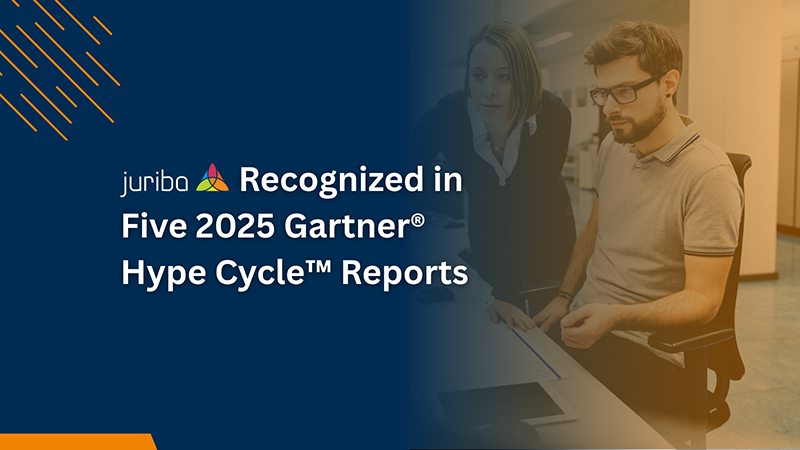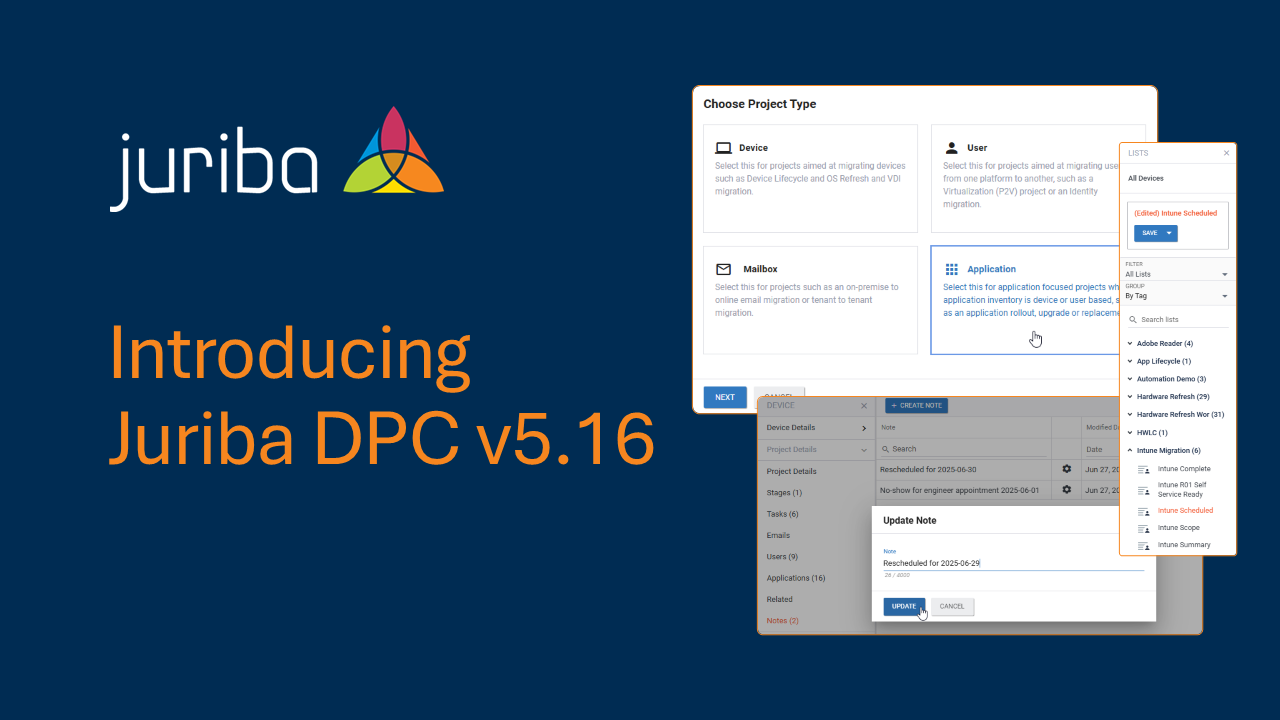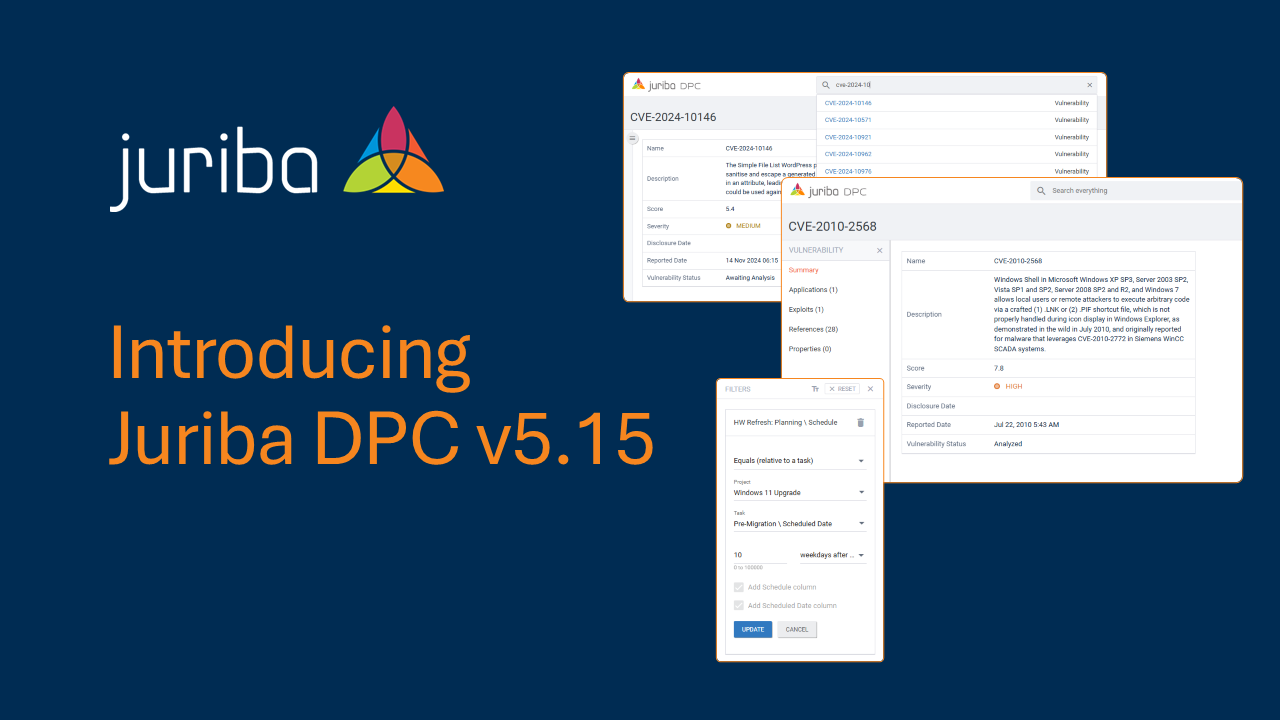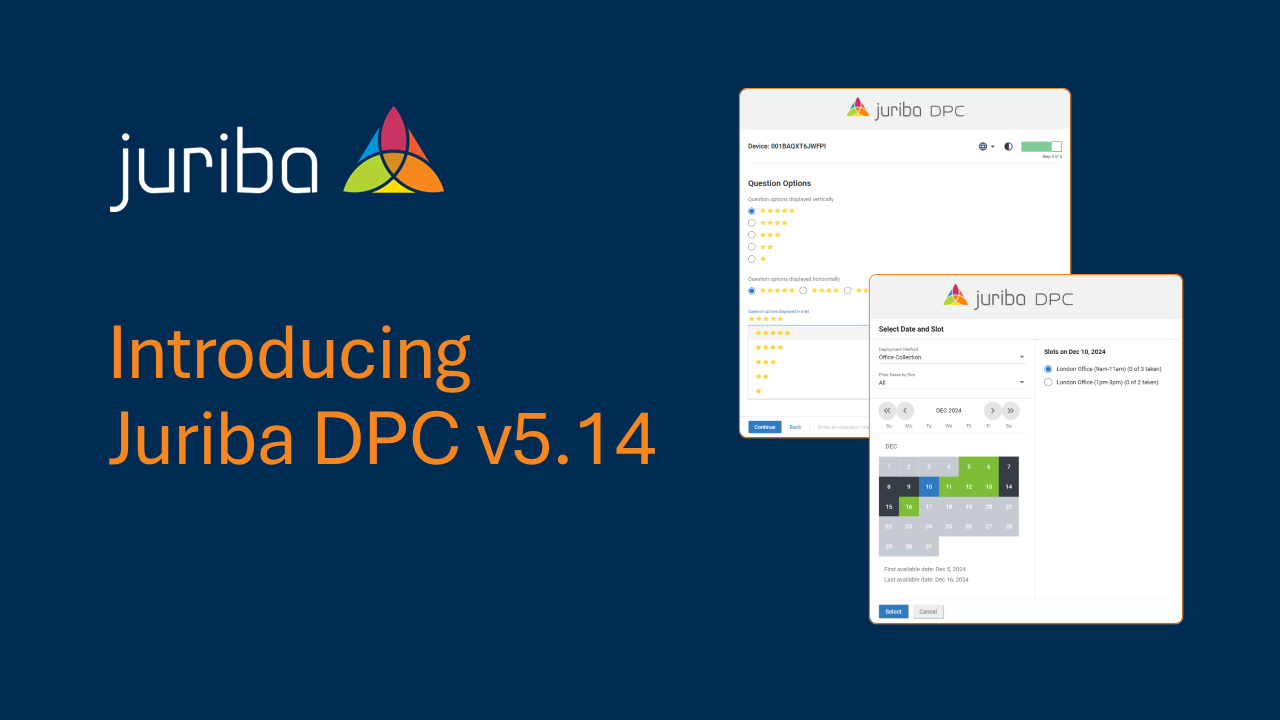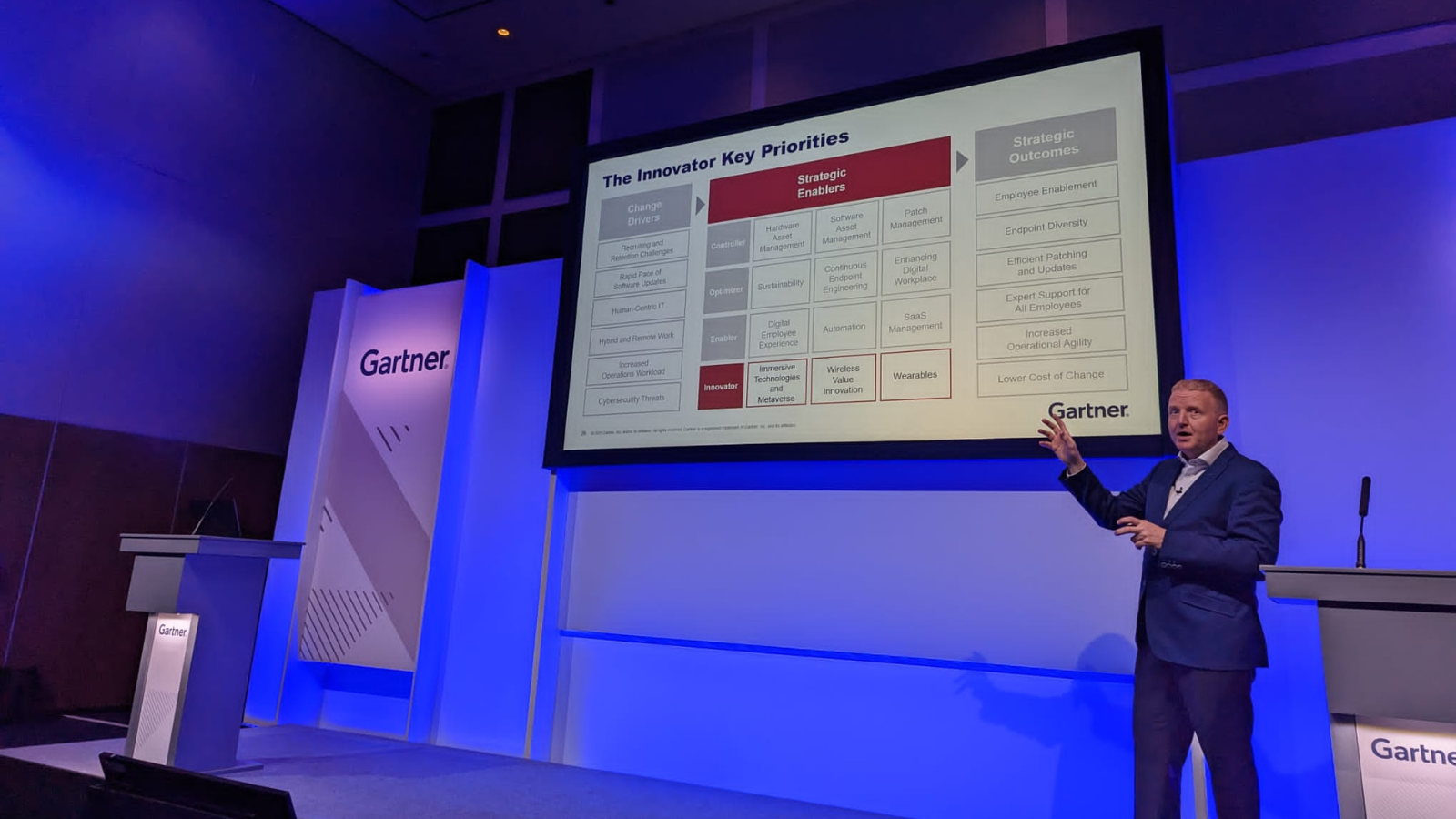Juriba evolves from Workplace Automation to Digital Platform Conductor for the Workplace
February 14th, 2023
4 min read
By Barry Angell

Over the past few years, the way organizations manage IT has drastically changed, and so has Juriba. Always a step ahead of the market, Juriba has transformed from an IT Transformation management tool to an Evergreen IT management solution in 2014 and is now becoming the first and only Digital Platform Conductor (DPC) on the market specifically designed to manage the Digital Workplace.
As we are currently making this transition, our customers are curious to understand what has led to this move and how Juriba fits into the DPC market in general. What does this mean for the strategic direction of Juriba as a company and its technology roadmap? In this article, I want to answer some of the most asked questions and explain how Juriba positions itself in this newly defined Gartner® market segment.
An evolution: from big-bang transformation projects to Evergreen IT Management to Digital Workplace Conductors
Remember migrating from Windows 7 to Windows 10 or your Office 365 email migration? For many workplace leaders, those projects are a painful but not-too-distant memory. Back then, it took two to three years of intense work to move everyone to a new OS or email platform. But technology started to change. Microsoft introduced Windows-as-a-Service, and many organizations scrambled to figure out how to adjust their internal processes, tooling, and skill sets to roll out smaller, more continuous updates at a much faster velocity. We called this new world Evergreen IT Management. It caused a massive shift in how we approached IT management: we moved the changes into our Business-as-Usual teams and applied the same principles that we use for patch management to OS lifecycle, all while adopting much smoother rollouts of hardware, applications, and other platform changes necessary to modernize the end-user workspace.
In parallel, enterprises were driving Digital Transformation initiatives with an increased focus on customer and employee experience, resulting in IT organizations embracing the Digital Workplace to enable "more effective ways of working, improving employee engagement and agility, and exploiting consumer-oriented styles and technologies." Consequently, organizations started to invest in a lot of different point solutions that promised to help manage the Digital Workplace. These include DEX tools, ITAM and ITSM tools, application stores, patch management solutions, application management solutions and the like. The challenge for workplace leaders is that these tools don't always provide an end-to-end solution. That is where a Digital Platform Conductor comes in.
What makes a Digital Platform Conductor so useful?
Gartner® first coined the term Digital Platform Conductor (DPC) in 2021, describing it as an emerging technology market segment that provides tools that "coordinate Hybrid Digital Infrastructure Management (HDIM) tools used to plan, implement, operate, and monitor underpinning technology and services for applications and digital products. They may be delivered as on-premise, Software-as-a-Service (SaaS), or Platform-as-a-Service (PaaS) and provide a unified view of digital infrastructure and dependent applications."
Two key elements make up a DPC:
- It is a digital platform which means it is, by definition, extensible. A DPC allows organizations to extract tangible business value from other (already existing) Hybrid Digital Infrastructure Management tools by integrating with them and making the whole better than the constituent parts. Gartner calls this "the cohesive view." DPCs can be deployed with existing environments and integrated with infrastructure already in place.
- It is a conductor in the sense that, by overlaying workflows needed for all kinds of IT management services across the other tools, it conducts activities across them, making existing tools better and providing tangible business value.
The DPC market is still in its infancy, and during its inception, Gartner identified nine core DPC capabilities. At this point, no vendor can claim complete coverage. Currently, various vendors are attacking the market from different angles; some come from a migration tooling perspective, some from an observability standpoint, and some from compliance or asset management angles that enable workflows to manage the IT lifecycle. Due to Juriba's experience and capabilities in helping enterprises manage their Digital Workplaces, Juriba is positioning itself as the Digital Platform Conductor for the Workplace.
What is Juriba's Digital Platform Conductor for the Workplace?
Since its creation in 2008, Juriba's goal has been to add tangible business value by making IT processes more efficient. The plan for Juriba has always been to build a platform that allows organizations to manage their IT environments more effectively, becoming the glue that holds everything together and adds business value to thousands of business activities that happen daily in an organization.
While the idea of "the one tool to rule them all" is very enticing, the reality is that there are many siloed tools working to manage bits and pieces of the Digital Workplace. The Juriba DPC brings those tools together with a tangible set of outcomes classed as accelerators, e.g., Windows 11 migration, device lifecycle management, and application lifecycle management. Business value-driven decisions become not only possible but the norm within a Business-as-Usual environment because, while we are still moving something from A to B, we expand the horizon to include a long-term customer technology roadmap view. This enables you to say, "Okay, now that we have done X, we should be doing Y, and therefore, we'll initiate Z," resulting in a much greater value.
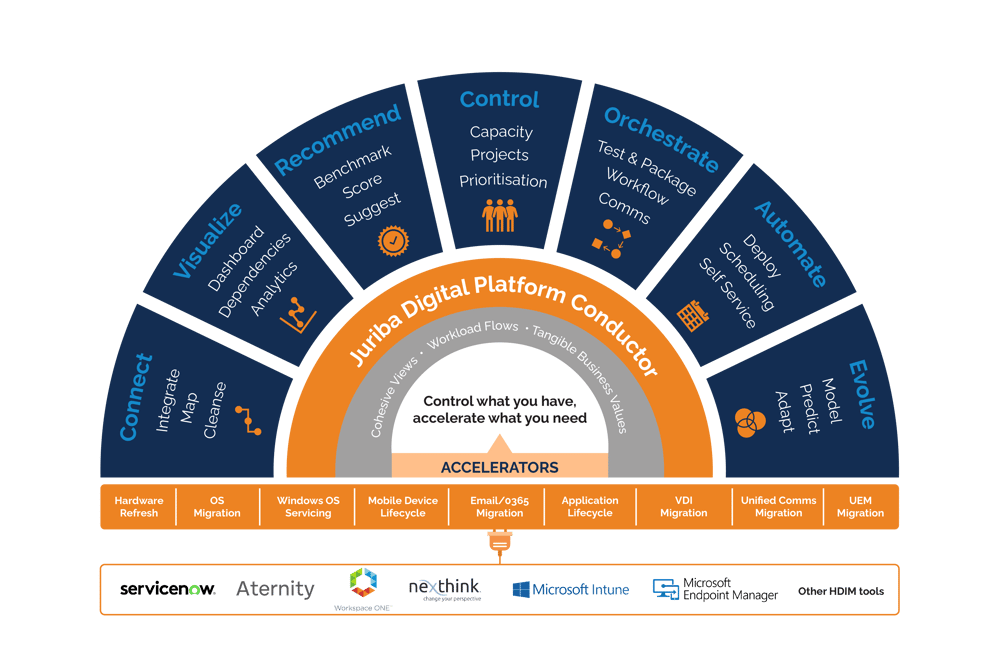
Because the DPC market is a platform play, one of the critical indicators for success is the strength of the ecosystem. Juriba has, from the get-go, been completely tool agnostic and integrates with all the large HDIM tools, like Microsoft MECM, AD, Azure AD, Intune, Exchange, Microsoft 365 (Mailbox), ServiceNow, Nexthink, Aternity, WorkspaceOne, and more. All large organizations have many of these tools already in production.
By layering a DPC like Juriba on top, not only are you able to extract higher ROI from your existing infrastructure investments but you can also create true synergies between these tools that previously didn't exist or would have taken a lot of custom development to create. An example could be automating and orchestrating workflows across your entire estate while observing your environment for any abnormality you might need to address. Rather than having to be purely reactive, you can assume a much more supporting and enabling role in your IT management. We refer to this as digital workplace enablement. As DPC capabilities advance, especially with cloud-based operation, and technology debt gets reduced within organizations through tighter management over the next 12 to 18 months or so, you will be able to shift your focus to empowering and transforming!
What problems are solved for enterprises by Juriba's Digital Platform Conductor for the Workplace?
Juriba's DPC for the Workplace allows strategic customers with complex IT environments to reduce costs, tighten security, and increase speed and agility for IT delivery. These priorities are especially crucial now with many companies tightening their belts to deal with the economic environment and the hangover from COVID-19 investment. Now, faced with inflation and looming recession, they are under growing pressure to cut costs, slim down technology stacks, and increase efficiencies.
By driving modern workplace management, Juriba targets adding business value around five distinct areas:
- Ultra-efficient Digital Workplace Management (enabling, managing, and optimizing the Digital Workplace to achieve maximum agility)
- IT Estate Modernization (reducing technical debt, keeping server and other infrastructure up-to-date, automated application packing and testing, and more)
- Minimal Fuss Transformational Projects (migrating to Windows 11, upgrading to Intune, VDI or AVD/Windows 365 adoption, etc.
- Business-as-Usual (BAU)/Lifecycle Management (OS, Application, Device Lifecycle Management, etc.)
- Governance & Security (constant application upgrades, OS security enhancements, platform changes, etc.
I am extremely excited to continue this conversation. We will answer more of your questions over the coming weeks and months as we further position Juriba in the DPC market and communicate our product roadmap to align with the new strategy. If you have any questions now, please feel free to reach out to me directly or comment below.
Barry is a co-founder of Juriba, where he works as CEO to drive the company strategy. He is an experienced End User Services executive that has helped manage thousands of users, computers, applications and mailboxes to their next IT platform. He has saved millions of dollars for internal departments and customers alike through product, project, process and service delivery efficiency.
Topics:





